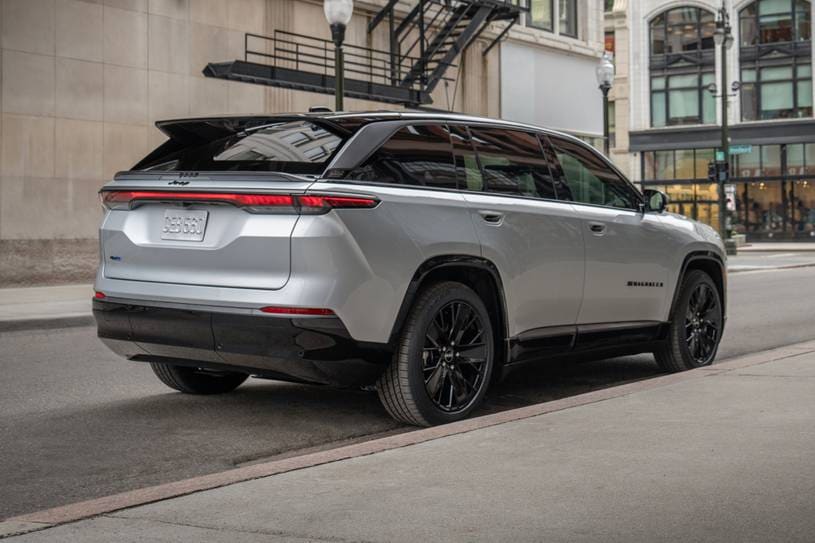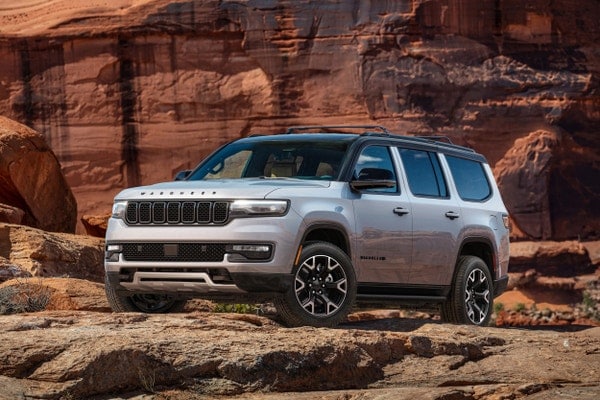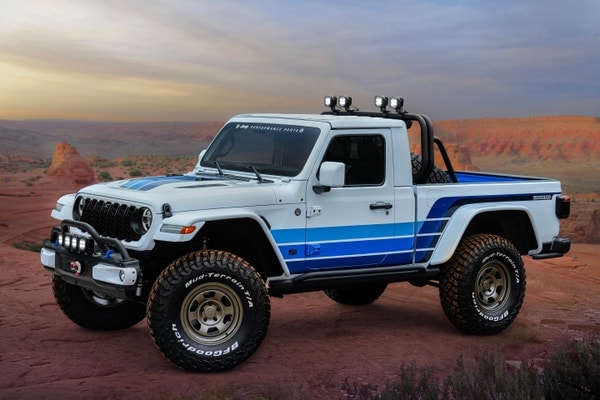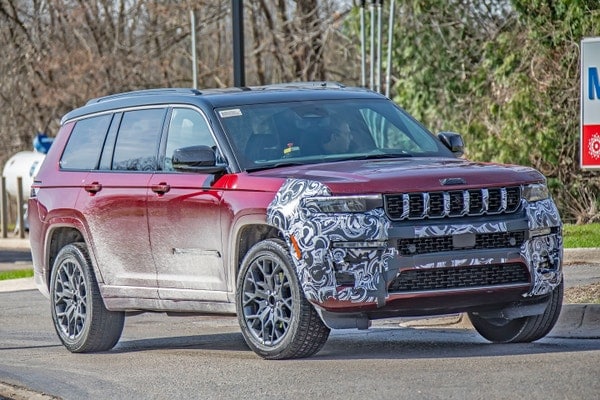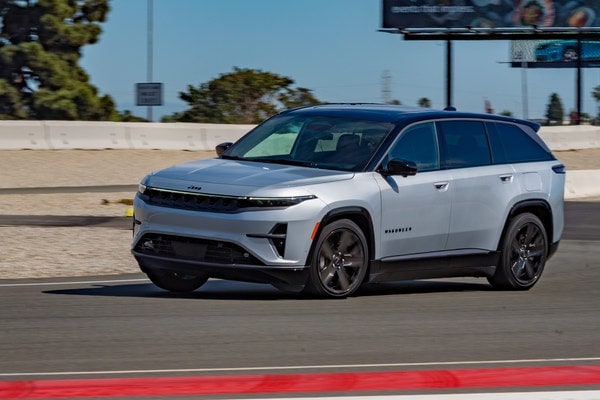Meet the brand-new 2024 Jeep Wagoneer S, the automaker's first global electric vehicle and a domestic shot across the bow at the Tesla Model Y and Cadillac Optiq. Not only does it have to prove that parent company Stellantis can do EVs right, but it also needs to justify why it's very, very late to the EV game. That means it's got quite a lot of ground to cover.
First things first, it looks like a Jeep. In person, the Wagoneer S has the look and feel of a Grand Cherokee from 2035. It maintains the Jeep signature seven-slot grille up front, narrow headlights that are pushed to the top corners of the hood line, and thin taillights merged into a full-width lightbar at the back. The Wagoneer S features more intricate surfacing and isn't as slab-sided as the brand's internal combustion engine offerings. And then there's that massive rear wing — its only job is to minimize the amount of air disturbed as the car moves along to help boost range.
Wagoneer S range and power figures
Despite sharing a name with a full-size SUV, this isn't a huge vehicle — it's much closer to your typical two-row crossover. The Wagoneer S' 113-inch wheelbase (the measurement between the front and rear wheel) puts it right in line with the Tesla Model Y and is within a few inches of the current Jeep Grand Cherokee in both wheelbase and overall length.
The first 2024 models to roll out will be top-spec Launch Editions. It uses a 100.5-kWh battery pack that feeds two electric motors (one in the front, one rear-mounted) for all-wheel drive. The motors make 600 horsepower and 617 lb-ft of torque and, according to Jeep, should scoot the Wagoneer S from 0 to 60 mph in 3.4 seconds.
Another speed that matters is charging, and while Jeep doesn't quote a peak charge rate for the Wagoneer S, it did say that it should be able to go from 20% to 80% in 23 minutes on a DC fast charger. The Wagoneer S has an EPA-estimated range of 303 miles on a single charge.
A plethora of drive modes will help put the power down. Auto, Sport, Eco, Snow and Sand are part of Jeep's trick traction management system that optimizes powertrain responsiveness and stability control intervention for a variety of surfaces. Approach, breakover and departure angles are 19.2 degrees, 14.0 degrees and 23.4 degrees, respectively — put another way, the Wagoneer S likely won't be rock crawling anytime soon. It might be silly to quote these angles for a near three-ton luxury EV crossover, but Jeep itself has already shown the Wagoneer S racing around on the dirt.
A Wagoneer-worthy interior and lots of tech
Inside is where things get a little more Wagoneer-ey. It has a similar dashboard layout to the brand's largest SUV. There's a configurable 12.3-inch driver display that serves as the instrument cluster and two central displays (the top controls most of the car's primary functions and its settings, while the lower is mostly dedicated to HVAC controls). Jeep says the center 12.3-inch screen has been optimized to provide sharper clarity and to make maps and images from the car's array of cameras more easily visible. There is also a 10.25-inch screen for the passenger that can be used to watch movies or control the Wagoneer's multimedia functions. Being Jeep's first EV means the Wagoneer S has to be a tech showcase for the brand, and the lack of physical controls is meant to convey this.
The tech angle also means the Wagoneer S comes with many of the modern features you'd expect of an EV SUV. Jeep is continuing its exclusive partnership with McIntosh to provide high-end audio systems for its flagship cars.
Other tech duds include a robust suite of safety features. Blind-spot warning, lane keeping assistance, front and rear cross-traffic alert, speed sign recognition, and an abundance of other driver assistance features are all standard on the 2024 Launch Edition. The Wagoneer S also gets Jeep's Active Driving Assist tech, a hands-free driving assistant that works up to 90 mph and only asks you to keep your eyes on the road as long as it's active.
How does the Wagoneer S drive?
On the street, the Wagoneer S feels stiff and heavy. You feel bumps both big and small, though it's really the smaller bumps that are the issue more than the larger ones. The ride is rarely harsh, but imperfections of all sizes make their way through to your buns and back. We expect a vehicle like this to have a smoother ride.
We also expect better braking performance. It can be difficult to consistently stop smoothly at stoplights and you can just feel the heavy mass of the vehicle whenever you speed up or slow down. The Wagoneer S offers full one-pedal driving — you can lift off the accelerator and the vehicle slows down without you having to use the brake pedal — but the regenerative braking system isn't able to bring the Jeep to a smooth stop.
Those are the Jeep's two largest issues, but the whole driving experience is fairly underwhelming. It's quick, sure, but only by Jeep standards. Edmunds has tested plenty of EVs with 0-60 mph times on par with that of the Wagoneer S. Electric motors have made acceleration cheap and easy. That's not enough to stand out anymore.
Somewhat disappointingly, the Wagoneer S doesn't do Jeep things all that well either. It's an SUV, but there's only 6.4 inches of ground clearance. Beware of parking curbs. Jeep hinted at a possible Trailhawk model with more off-road capability, but don't expect the Jeep version of a Rivian R1S.
Launch Editions — the only trim available for the first year — are fully loaded and have a starting price of $71,995, including destination charges. Jeep would only hint at changes for 2025, but expect more affordable Wagoneer S variants will be available.



